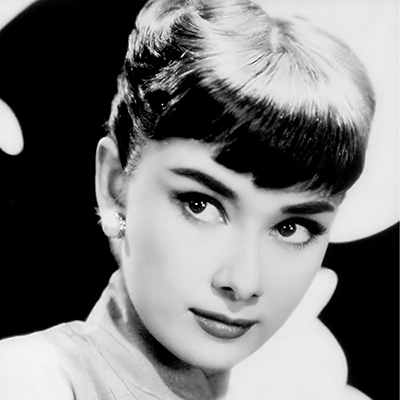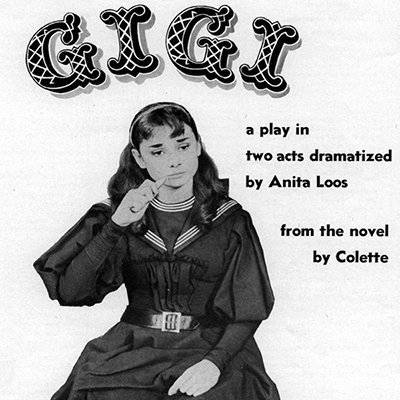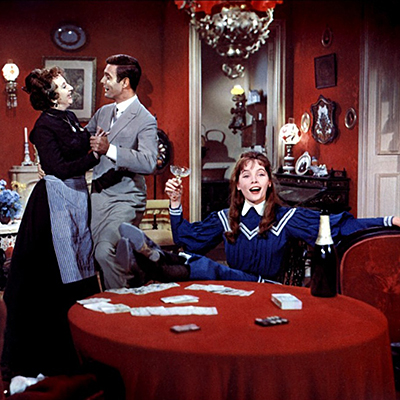History Lesson! Learn How Colette, Audrey Hepburn, Leslie Caron & Vanessa Hudgens Transformed Gigi
Get ready for a new twist on an old favorite, as Gigi officially opens April 8 at the Neil Simon Theatre! Vanessa Hudgens, Victoria Clark, and Corey Cott star in the highly anticipated musical, which took close to a decade to get to the Great White Way. That, however, is a small part of the story. Before you thank heaven for little girls, read the story of Gigi.

Gigi sprang from the headlines
Before Leslie Caron and Vanessa Hudgens, Gigi began with another famous woman: Colette. In the 1944 novelette, a young Parisian courtesan (read: fancy prostitute) learns the family trade from her grandmother and great-aunt and ends up with the older Gaston. Colette’s big influence was the 1926 marriage of 18-year-old ballerina Yola Henriquez to the 58-year-old Henri Letellier, editor of Le Journal.

Colette played talent scout
A popular book means one thing: adaptations! After a 1949 French film, a Broadway play by Anita Loos (Gentlemen Prefer Blondes) followed. When wheelchair-bound Colette was being pushed along the Monaco seafront, she spotted a waifish beauty wearing a one-piece black swimsuit. “Voilà ma Gigi!” she reportedly exclaimed to her husband. “She seemed to have a line drawn around her, the way some only children have,” Loos later said. “Whatever she did, she stood out.” There was only one problem: Young Audrey Hepburn had never spoken onstage.

Audrey Hepburn's grace arrived gradually…
Initially, Hepburn’s projection was so bad, co-star Cathleen Nesbitt could barely hear her from the stalls. The overwhelmed ingénue got asthma attacks. When Hepburn arrived in New York via boat from England, Miller discovered his rising star had gained weight. Hepburn, who kept late hours with then-fiancé Jimmy Hanson, garbled lines and was “giving a reading of the part instead of playing it on feeling,” according to Alexander Walker in Audrey: Her Story. Director Raymond Rouleau ordered his leading lady to get it together.

…But exploded on opening night
Ready or not, 23-year-old Hepburn faced the Broadway crowd on November 24, 1951. She was immediately adored. “Her quality is so winning and so right that she is the success of the evening,” gushed The New York Times. “She is able to put on an athletic show that would shame a track meet,” Esquire raved. Within days of opening night, Walker observed in Audrey: Her Story, the show’s neon sign transformed from “Gigi with Audrey Hepburn” to “AUDREY HEPBURN in Gigi.”

A musical wasn’t part of the plan
Hollywood studios, including MGM, had been interested in Gigi since 1950, but the story violated the stodgy Motion Picture Production Code. “The problem is so basic to the picture that we cannot suggest any eliminations which might bring it into conformity with the Code," censorship czar Joseph Breen declared. Producer Arthur Freed (An American in Paris) persisted, submitting Colette’s story and Loos’ script to the production code office in 1953. Still no. A year passed. Loos reached out to Freed, asking him to turn Gigi into a musical. Inspiration struck, and Freed assembled a creative team.

The creative team needed convincing
Freed hoped a Gigi movie musical would be the perfect project for An American in Paris director Vincente Minnelli—but Minnelli had no interest in the play, which he deemed “too farcically played” and, ultimately, “not very good.” Next, Freed and Minnelli turned to Alan Jay Lerner and Frederick Loewe. Lerner signed on, but Loewe, who insisted he was devoted to the theater, declined. In 1957, Lerner submitted a script that pleased the production code prudes at MGM. That script, plus the invitation to write songs in Paris, ultimately convinced Loewe to sign on.

Gigi marked the end of an era
Gigi, starring Leslie Caron as Gigi and Louis Jordan as Gaston, nabbed nine 1958 Academy Awards, including Best Picture. Success was bittersweet for MGM, the movie musical masters. “Gigi was [MGM’s] last hurrah as the studio system broke down while trying to adapt to the changing tastes of a new modern generation,” noted TCM’s Andrea Passafiume. That, and the rise of the women’s movement, perhaps explains why Lerner and Loewe’s 1974 Broadway musical adaptation, starring Karin Wolfe as Gigi and Daniel Massey as Gaston, closed after 103 performances.

The musical rides again
Former MTV exec Jenna Segal first watched Gigi at age six when she was battling the stomach flu. It became her non-stop entertainment for the week—and the inspiration behind her second career. Segal, who had no experience as a Broadway producer, spent seven years getting Gigi to the Great White Way. She secured the rights from the estates of Lerner and Loewe, hired writer Heidi Thomas and director Eric Schaeffer (above) and raised the $12 million herself. "I'm from New Jersey, and we don't quit,” Segal told The Bergen Record.

At first, Vanessa Hudgens was skeptical
Evan Hainey, Vanessa Hudgens’ manager, got her client an audition for the title role in the new revival. The High School Musical favorite was baffled. “I called him back and was like, ‘Evan, do you really think I should go do this? I don’t see how they see me as a teen in Paris in the late 1800s,” she told The Washington Post. “I’m Filipino.’ He said, ‘No, they’re interested.’” As soon as Hudgens left the audition, Segal emailed her an offer.

A Gigi for a new generation
After a successful run in Washington, D.C., the newly transformed Gigi is ready for Broadway. The young student is now 18 and, according to Hudgens, “kind of a punk.” Gaston is 25 and a Prince Harry-like celebrity. The signature song “Thank Heaven for Little Girls,” is now sung by Gigi’s grandmother and aunt, not Honoré Lachaille. “We had to get the perv factor out of it—that was the mission from day one,” Schaeffer told The New York Times. “Gigi is very strong, independent and empowering,” Hudgens told Broadway.com. “It's an important story to be told to a modern-day audience.” So get going—and bring the whole famille!
